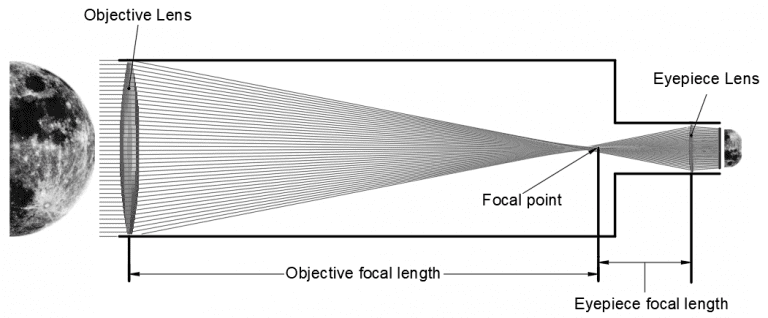Key Takeaways
- Telescopes rely on precise optics and mirrors, and their customization allows for optimized performance tailored to specific observing needs.
- Modern telescopes favor mirrors over lenses due to their lighter weight and ease of achieving a smooth surface, essential for clear imaging.
- Refractors and reflectors (like the Newtonian design) have distinct structures, with refractors using lenses and reflectors using mirrors to gather and focus light.
- Customizing telescopes involves selecting appropriate eyepieces, Barlow lenses, filters, and collimation tools, with professional services like those from Avantier offering advanced modifications and customization for superior optical performance.
Telescopes: Optics, Mechanics, and Customization
Telescopes, based on the principle of angular magnification, enable viewers to observe distant objects by enlarging their angular fields. This involves pairing optical elements with specific powers to modify the angular field. Despite the apparent complexity, the concept is straightforward, simplifying the construction of telescopes.
How Do Telescopes Work?
Telescopes, tools used by astronomers to observe distant objects, primarily employ curved mirrors to gather and focus light from the night sky. Initially, they used lenses made of curved glass, but modern ones use mirrors due to their lighter weight and ease of achieving a perfectly smooth surface.
The optics of a telescope, whether mirrors or lenses, must be nearly flawless to concentrate light effectively. The larger the optics, the more light a telescope can gather, contributing to clearer images. The choice between refractors and reflectors depends on the practicality of the design, with most modern observatories favoring reflectors for their size.

What are the Parts of a Telescope?
A refractor consists of a long tube containing lenses, with the objective lens at the front and the eyepiece in a secondary tube. Adjusting the lenses in the eyepiece focuses the image. On the other hand, a classical Newtonian reflector has an objective mirror at the end of the tube and a secondary mirror at a 45-degree angle to the primary mirror. The eyepiece is on the side of the tube.
Why Mirrors Work Better
Reflecting telescopes, using mirrors, offer advantages over lenses. Mirrors can be thin, requiring less weight, and are easier to clean and polish. However, they flip images, which is corrected using additional mirrors.
Important Specifications of the Lens
Telescope lenses have critical specifications:
- Aperture Diameter: Determines the amount of light it can gather.
- Focal Length: Affects magnification and field of view.
- F/number: Influences the its speed and low-light performance.
These specifications are fundamental for understanding a telescope’s capabilities.
Customizing Telescope Lenses
Customization involves:
- Choosing the Right Type of Lens: Consider refractors or reflectors based on observing preferences.
- Selecting Eyepieces: Different eyepieces offer varied magnifications and fields of view.
- Barlow Lenses: Increase magnification without additional eyepieces.
- Filters: Enhance views by selectively blocking certain wavelengths of light.
- Collimation Tools: Align optical elements, crucial for reflector telescopes.
- Astrophotography Accessories: Improve image quality and enable long-exposure photography.
- Upgrading Optics: Consider professional assistance for advanced modifications.
Optical Enhancement Services: Elevate Your Telescope’s Performance with Professional Expertise”
When it comes to upgrading the optics of your telescope, the process involves refining the primary lens or mirror to achieve superior optical performance. This intricate procedure benefits significantly from professional assistance, and our team at Avantier, a leading custom optics company, is here to provide expert guidance.
Our team, composed of skilled telescope technicians, possesses the specialized knowledge required to meticulously assess your specifications. We guide you through the selection and implementation of advanced modifications tailored to meet your specific needs.
Opting for our professional assistance ensures a seamless integration of upgraded optics into your telescope system, thereby optimizing its overall performance. Advanced modifications may encompass precise adjustments to the primary lens or mirror, fine-tuning of focal lengths, and the incorporation of specialized optical components, including substrates, coatings, filters, and reflectors.
GREAT ARTICLE!
Share this article to gain insights from your connections!




